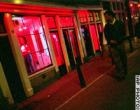Red light on Dutch sex for sale

But another image of prostitution is starting to emerge -- that of unwilling women trafficked by criminal gangs.
This month, Dutch authorities launched a campaign to fight forced prostitution by urging clients to alert police if they suspect women are being coerced into selling themselves.
The campaign triggered a passionate debate and led to calls for the notorious Dutch red-light districts to be shut down.
"People see the window prostitutes and open sex industry here and believe there is lots of money to be made," said Tatjana, who was trafficked from eastern Europe and forced to work as a prostitute.
"Gangs want a share of this so they bring in women of their own," she said. Tatjana, who did not want to give her last name, now works to identify other victims of trafficking.
One rights group estimates that around 3,500 women are trafficked to the Netherlands each year from eastern Europe and Asia to work in secret brothels or illegal escort agencies, where they are often held captive and abused.
Last year, Dutch police received more than 600 tip-offs about women who may have been forced into prostitution, and 400 women contacted the Dutch foundation against female trafficking.
Yet, the new campaign to raise client awareness -- through billboards, flyers and magazine advertisements -- has infuriated some in the industry, who say the numbers are exaggerated and reflect a moralistic urge to portray prostitutes as victims because of a deep-rooted aversion to their trade.
"This district is 700 years old and we've had trafficking in women for almost the same amount of time. It exists -- but nothing like to the extent people have been saying," said Mariska Majoor, a former prostitute who now runs an information center in the heart of Amsterdam's red-light zone.
"Making enforced prostitution such a dramatic issue only makes it harder for those women who need to ask for help. They feel more ashamed and stigmatized," she added.
Public outcry
Harrowing accounts from trafficking victims have stoked public outcry in recent weeks, even if they have done little to dent the numbers drawn to the capital's historic sex quarter.
Tourist authorities admit the district -- a maze of narrow alleys and canals lined with sex shops, brothels and neon signs -- is as big an attraction as Amsterdam's museums and coffee shops, where marijuana is freely smoked and sold.
Every night visitors throng the streets, agog at the scantily clad women sitting behind clear windows.
Lodewijk Asscher, head of the PvdA Labour party that runs the council in Amsterdam, wants the district closed down.
"I'd rather we had one tourist attraction less than be complicit in the abuse of women," he said.
While Asscher may not have the power to do so, the idea of closing down red-light districts is no fantasy in a land where famed tolerance has started to crack since brutal murders exposed deep rifts and suspicion between communities.
A red-light district in the eastern town of Arnhem was closed at the start of 2006 after 40 years as authorities tired of the crime and disorder it attracted.
Duped
Tatjana, like many other eastern European women, was tricked by a person she trusted into leaving her home country aged 20, drawn by promises of a better future and easy money.
She declined to give her age or nationality, for fear she might be identified.
Once she arrived in the Netherlands the man she had thought of as a boyfriend sold her to criminals. She got away by chance after their violence attracted the police.
"When you force a woman into prostitution you steal a life, you steal her future. She loses everything and later she is too ashamed even to have contact with her family," she said.
It depresses her, she says, when she hands out campaign material to supposedly self-employed window prostitutes in Amsterdam or Rotterdam, only to see pimps emerge from the shadows just a few seconds later and take it from their hands.
The new awareness campaign includes posters giving details of an anonymous phone line clients can use if they suspect a woman is being forced into prostitution.
"Have you seen the signals?," the posters ask, listing fear, bruising and poor English or Dutch.
Intuition
"A good client has enough intuition to know when a prostitute is forced to have sex and will raise his concerns," said Majoor from the information center.
Tatjana also believes clients can provide vital clues -- often unwittingly. Internet chatter once led her to a secret brothel in the Dutch countryside where 11 girls were trapped.
Distrust of the police and stories of light sentences for pimps frequently make such victims too scared to seek help.
Majoor, who became a prostitute aged 16 for the money, believes only around 20 percent of Amsterdam's prostitutes are forced to work by a pimp -- but she said not all pimps traffic women, some just prey off women already working as prostitutes.
She believes society must rethink its pitying attitude.
"If a girl from eastern Europe works here to support her family at home, she is not forced into anything. She is just a brave person who has chosen a particular way to make a living."

No comments added!